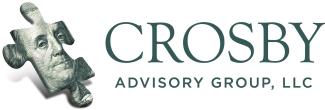
7 Moves to make in 2024: Move 1
7 Moves to Make in 2024: Move #1
As the New Year begins, people everywhere will be pondering the resolutions they will make in 2024 to improve their lives. By far, most resolutions will revolve around health and wealth. To help those who resolve to make the latter goal a priority, we are launching a series titled, “7 Financial Moves to Make in 2024." In each newsletter, we will briefly discuss each of the seven moves we recommend that you consider in 2024. For our clients who live in Geauga County, we will also be presenting these financial moves to the Chardon Chamber of Commerce on January 24th. We hope to see you in attendance. We outline many of these concepts in our new book “Dynamic Growth,” which will be available in the first half of 2024.
Dial in Your Savings Rate
Unless you are able to sell a successful business, win the lottery, or inherit a large sum of money, chances are your wealth will be built over decades of consistent, positive action. Those new to investing can make the mistake of starting with financial products. The world’s best stock ETF can’t build sustained wealth without first addressing the fundamentals of your plan. Later in the series, we will demonstrate how to structure a wealth accumulation plan to work in real life, as well as on paper, but before we get there, we need to start with step one: dial in your savings rate.
There are three components to wealth accumulation: savings rate, investment return, and time. By far, you have the most control over your savings rate. An investor with a proper savings rate will succeed, even if the investments they use are mediocre. How much should you be saving? The CFP Board recommends a savings rate of 11 to 15% of your take-home income. This amount may need to be more if you are starting to save for retirement after age 40. We need to plan for a long retirement. If a married couple both reach age 65 in the same year, there is approximately a 50% chance that one of them will live to age 90. It’s difficult to fund a 25-year retirement by only saving 10% or less of your working income. At Crosby Advisory Group we work to help clients achieve at least an 11-15% savings rate. How do you calculate your savings rate?
If asked, “How much do you make per year?” Many people have to stop and think. Perhaps they may even need to look at their tax return, but nearly everyone can tell you how much is deposited into their bank from their paycheck. To calculate a 15% savings rate, simply multiply your paycheck x 0.15. For example, if Mark Doright earns $1,000 per week, then $150 should be allocated toward his accumulation plan. Keep in mind that this calculation is for someone who does not participate in an employer-provided retirement plan such as a 401k or SIMPLE IRA. Employer-provided retirement plans typically match your contributions up to a specific dollar amount. Back to Mark Doright, he works for Anytown Manufacturing and his company matches his contributions to their retirement plan, dollar for dollar, up to 3% of his wages. This means for Mark to obtain a 15% savings rate, he only needs to save 12% of his own money. The remaining 3% is provided by his employer, allowing Mark to achieve his 15% savings rate. While we would not recommend Mark put all 12% into his employer’s plan, at this stage we only need to know that an employer-provided retirement plan that offers a match can help you achieve your target savings rate for less out of pocket investment.
“Nate, you’ve lost touch with reality, the cost of living has gone up dramatically, and I can’t spare 15% of my paycheck to save and invest.” It’s not easy, but it’s possible. I know because we help clients get there. Remember, I said there were three components to wealth accumulation: savings rate, investment return, and time. Of those three, the second most important component is time. Time is the scarcest of all resources; much more scarce than money. It is said that the best time to plant a shade tree was 20 years ago, the second best time is right now. While your savings rate provides the fuel, it is time that allows for the miracle of compound growth. If presently, you can only save 5% of your paycheck, then start now. We can get you to a 15% savings rate over time, but we can’t get back in time, so start with what you can save. Here are two strategies to help you boost your savings rate over time.
As you progress in your career, you are going to make more money. One trick to boost your savings rate is to take half of every raise and allocate it to your accumulation plan. If you made it through the previous year on your old income, you could make it through the next year with your old income plus half of your raise. If you allocate 50% of your future raises to your accumulation plan you will likely be at or above 15% in a matter of years. The second solution is to reign in your spending habits. I recommend that everyone run a spending analysis at least once a year. Pick any month other than December. You can download a workable spending tracker on our website. Each year I force myself to run a spending analysis on myself. I always find something I can do if my savings rate falls below my target. The way we purchase food, insurance, utilities, vehicles, memberships, and discretionary spending, can all be manipulated to help free up money to save and invest. It’s not easy, but if you have resolved to make financial independence a priority, then your first step is to dial in your savings rate.
Tune into our next six (6) newsletters for additional moves that can help power your accumulation plan in 2024.
For additional information please contact:
- Carly Snyder: Business Growth and Marketing csnyder@crosbyadvisory.com
- Julie Maglott: Insurance julie@nmdinsurance.com
- Nate Crosby: Investment and Planning ncrosby@crosbyadvisory.com
- Derek Ballinger: Investment and Planning dballinger@crosbyadvisory.com
- Office: 419.496.0770
Disclaimer: CAG is a registered investment advisor in Ohio, Florida, Texas and Wisconsin. CAG provides financial planning and business growth strategies. This newsletter is for informational purposes and does not represent individual investment advice. Investing involves risk including potential loss of principal.

